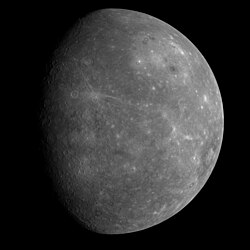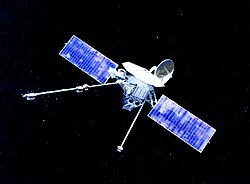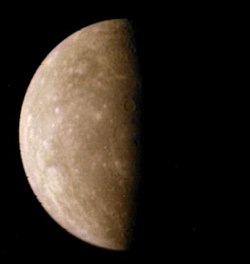Exploration of Mercury
 From Wikipedia - Reading time: 15 min
From Wikipedia - Reading time: 15 min
The exploration of Mercury has long had a minor role in the space interests of the world. It is the least explored inner planet.[1] As of 2025, the Mariner 10, MESSENGER and BepiColombo missions have been the only spacecraft that have made close observations of Mercury. MESSENGER made three flybys before entering orbit around Mercury.[2] A third mission to Mercury, BepiColombo, a joint mission between the Japan Aerospace Exploration Agency (JAXA) and the European Space Agency, is to deliver two probes into Mercury orbit in 2026, having previously made six flybys of the tiny planet. MESSENGER and BepiColombo are intended to gather complementary data to help scientists understand many of the mysteries discovered by Mariner 10's flybys.
Compared to other planets, Mercury is difficult to explore. The speed required to reach it is relatively high, and its proximity to the Sun makes it difficult to maneuver a spacecraft into a stable orbit around it.[3] As a result, all spacecraft sent to visit Mercury as of 2025 have required a complex trajectory of gravity assists, highly efficient ion propulsion, or both. The thermal environment around Mercury is also challenging, with probes utilizing sunshields, specially designed materials, or radiators to survive the heat so close to the Sun.
Interest in Mercury
[edit]Few missions have targeted Mercury because it is very difficult to obtain a satellite orbit around the planet. Mercury orbits the Sun very quickly (between 24.25 miles per second (39.03 km/s) and 30 miles per second (48 km/s)), so spacecraft must be travelling very fast to reach it. Mercury's close proximity to the Sun means that spacecraft are accelerated even further by the Sun's gravitational pull, requiring significant fuel expenditure in order to decelerate for orbit insertion.[4] Mercury's lack of any significant atmosphere[5] poses further challenges because it precludes aerobraking. Thus a landing mission would have even more demanding fuel requirements.[6]
Missions
[edit]Past missions
[edit]Mariner 10
[edit]Mariner 10 was a NASA probe whose primary objective was to observe the atmosphere, surface, and physical characteristics of Mercury and Venus. It was a low-cost mission completed for under $98 million.[7] Mariner 10 was launched at 12:45 am EST on November 3, 1973, from Cape Canaveral.[8] Since Mercury is so close to the Sun it was too difficult to incorporate an orbit around Mercury in the route so Mariner 10 orbited the Sun. In order to reach its destination, the satellite was accelerated with the gravity field of Venus. It then passed close to Mercury on March 29, 1974, as it flew towards the Sun. This was the first observation made of Mercury at close range. After the encounter Mariner 10 was in an orbit around the Sun such that for every one of its orbits Mercury made two, and the spacecraft and the planet would be able to meet again. This allowed the probe to pass by Mercury two additional times before completing the mission; these encounters were made on September 21, 1974, and March 16, 1975. However, since the same side of Mercury was illuminated during each of the flybys, at the conclusion of the mission Mariner 10 had only photographed approximately 45 percent of its surface.[9] The mission ended when the probe's attitude control gas ran out on March 24, 1975. As the spacecraft was no longer controllable without its nitrogen gas thrusters, a command was sent to the probe to shut down its transmitter.[10]
The close observations collected two important sets of data. The probe detected Mercury's magnetic field, which is very similar to Earth's. This was a surprise to scientists, because Mercury spins so slowly on its axis. Secondly, visual data was provided, which showed the high number of craters on the surface of the planet.[11] The visual data also allowed scientists to determine that Mercury had "not experienced significant crustal modification”.[12] This also added to the mystery of the Mercurian magnetic field, as it was previously believed that the planet's magnetic fields are caused by a dynamo effect of a molten core, but the lack of crustal change brought this idea into question. The visual data also allowed scientists to investigate the composition and age of the planet.[13]
MESSENGER
[edit]
MESSENGER · Mercury

MESSENGER (Mercury Surface, Space Environment, Geochemistry, and Ranging) was a NASA orbital probe of Mercury. It was launched from Cape Canaveral on August 3, 2004, after a one-day delay due to bad weather.[14][15] It took the probe about six and a half years before it entered orbit around Mercury. In order to correct the speed of the satellite it undertook several gravitational slingshot flybys of Earth, Venus and Mercury. It passed by the Earth in February 2005 and then Venus in October 2006[2] and in October 2007. Furthermore, the probe made three passes of Mercury, one in January 2008, one in October 2008 and one in September 2009, before entering orbit in 2011. During these flybys of Mercury, enough data was collected to produce images of over 95% of its surface.
MESSENGER used a chemical bi-propellant system both to reach Mercury and achieve orbit.[16] MESSENGER's scheduled orbital insertion took place successfully on March 18, 2011. In November 2012, NASA reported that MESSENGER had discovered a possibility of both water ice and organic compounds in permanently shadowed craters in Mercury's north pole.[17] The mission was scheduled to end sometime in 2012, when it was estimated that there would no longer be enough fuel to maintain the probe's orbit.[18] The primary mission was completed on March 17, 2012, having collected close to 100,000 images.[19] MESSENGER achieved 100% mapping of Mercury on March 6, 2013, and completed its first year-long extended mission on March 17, 2013.[20] In February 2013, NASA published the most detailed and accurate 3D map of Mercury to date, assembled from thousands of images taken by MESSENGER.[21] The probe continued collecting scientific data until April 30, 2015, when under a decaying orbit, the probe was allowed to crash onto the surface of Mercury.[22][23]

The MESSENGER mission was designed to study the characteristics and environment of Mercury from orbit. Specifically, the scientific objectives of the mission were:[24][25]
- characterize the chemical composition of Mercury's surface.
- study the geologic history.
- elucidate the nature of Mercury's magnetic field (magnetosphere).
- determine the size and state of the core.
- determine the volatile inventory at the poles.
- study the nature of Mercury's exosphere.
Ongoing missions
[edit]BepiColombo
[edit]
BepiColombo consists of two spacecraft: the Mercury Planetary Orbiter (MPO) and Mio (Mercury Magnetospheric Orbiter, MMO). Each orbiter has a distinct purpose: the MPO is to acquire images in several wavelengths to map the surface and exosphere composition of Mercury, and Mio's is to study the magnetosphere. It is a joint mission of the European Space Agency and Japan Aerospace Exploration Agency; ESA provided the MPO, while JAXA provided Mio.[3] The BepiColombo mission will attempt to gather enough information to answer these questions:
- What can we learn from Mercury about the composition of the solar nebula and the formation of the planetary system?
- Why is Mercury's normalized density markedly higher than that of all other terrestrial planets, as well as the Moon?
- Is the core of Mercury liquid or solid?
- Is Mercury tectonically active today?
- Why does such a small planet possess an intrinsic magnetic field, while Venus, Mars, and the Moon do not have any?
- Why do spectroscopic observations not reveal the presence of any iron, while this element is supposedly the major constituent of Mercury?
- Do the permanently shadowed craters of the polar regions contain sulfur or water ice?
- What are the production mechanisms of the exosphere?
- In the absence of any ionosphere, how does the magnetic field interact with the solar wind?
- Is Mercury's magnetised environment characterized by features reminiscent of the aurorae, radiation belts and magnetospheric substorms observed on Earth?
- Since the advance of Mercury's perihelion was explained in terms of space-time curvature, can we take advantage of the proximity of the Sun to test general relativity with improved accuracy?[3]
Like Mariner 10 and MESSENGER, BepiColombo used gravity slingshots from Venus and Earth. BepiColombo uses solar electric propulsion (ion engines) and similar maneuvers at the Moon, Venus, and Mercury. These techniques slowed the orbiters as they approach Mercury. It is essential to avoid using fuel to slow the orbiters as they get closer to the Sun to minimize the gravitational influence of the Sun.[2]
The BepiColombo mission was approved in November 2009,[26] and successfully launched on October 20, 2018. It was scheduled to enter orbit around Mercury in December 2025, but a loss of performance of its ion thrusters have delayed this to November 2026.[27] Its primary mission will last until April 2028, with a possible extension to April 2029.[28]
Proposed missions
[edit]Mercury-P (Меркурий-П/Mercury-Landing) is a proposed lander mission to Mercury by the Russian Space Agency. The probe would utilize solar-electric propulsion to reach Mercury orbit, before deploying a semi-hard lander based on those developed for the Mars-96 project.[29]
In August 2020, the Applied Physics Laboratory proposed the Mercury Lander for NASA's New Frontiers program. If selected, it would launch in March 2035 and land in April 2045.[30]
Canceled missions
[edit]Mercury Observer was a cancelled proposal in the Planetary Observer program, which was terminated after the loss of its first mission, Mars Observer.
Comparison of MESSENGER and BepiColombo
[edit]BepiColombo was designed to complement the findings of MESSENGER and is equipped with far more measuring equipment than MESSENGER to obtain a larger range of data. The orbital patterns of BepiColombo and MESSENGER are significantly different.[16]
The BepiColombo mission comprises two satellites launched together: the Mercury Planetary Orbiter (MPO) and Mio (Mercury Magnetospheric Orbiter, MMO). The MPO will have a circular orbit much closer to Mercury. The reason for this orbit is that the MPO will be measuring the composition of the surface and exosphere, and the close orbit will aid on data quality. On the other hand, Mio (MMO) and MESSENGER took largely elliptical orbits. This is because of the stability of this orbit and the lower amount of fuel required to obtain and maintain this orbit.[31] Another reason for the different orbits of Mio and MESSENGER was so that the data collected by Mio would complement that of MESSENGER, providing more accurate measurements.[16]
See also
[edit]References
[edit]- ^ JHU/APL (2006). MESSENGER: MErcury Surface, Space ENvironment, GEochemistry, and Ranging Retrieved on 2007-01-27
- ^ a b c Munsell Kirk-editor (November 6, 2006). NASA: Solar System Exploration: Missions to Mercury Archived September 29, 2006, at the Wayback Machine. Retrieved on 2007-01-27.
- ^ a b c ESA (2007). BepiColombo. Retrieved 2007-02-01.
- ^ Ley, Willy (July 1968). "Interplanetary Communications". For Your Information. Galaxy Science Fiction. pp. 116–124.
- ^ Munsell Kirk-editor (November 6, 2006). NASA: Solar System Exploration: Planet Mercury Archived September 29, 2006, at the Wayback Machine. Retrieved on 2007-01-27.
- ^ "Critical decisions on Cosmic Vision".
- ^ Shirley, 2003
- ^ Dunne, James A. (1978). The Voyage of Mariner 10: Mission to Venus and Mercury (NASA SP-424). U.S. Government Printing Office. p. 45. ASIN B000C19QHA.
- ^ Mix, Lucas John (2009). Life in Space: Astrobiology for Everyone. Cambridge, Massachusetts London, England: Harvard University Press. ISBN 978-0-674-03321-4.
- ^ Murray, Bruce; Burgess, Eric (1977). Flight to Mercury. New York: Columbia University Press. p. 138. ISBN 9780231039963.
- ^ Dunne, 1978, p. 74
- ^ Dunne, 1978, p. 101
- ^ Dunne, 1978, p. 103
- ^ Malik, T. (2004). Mercury MESSENGER Launch Postponed. Retrieved 2015-07-18.
- ^ NBC News (2004). NASA launches spacecraft to Mercury. Retrieved 2015-07-18.
- ^ a b c McNutt, Ralph L.; Solomon, Sean C.; Grard, Réjean; Novara, Mauro; Mukai, Toshifumi (2004). "An international program for Mercury exploration: Synergy of MESSENGER and Bepi Colombo". Advances in Space Research. 33 (12): 2126–2132. Bibcode:2004AdSpR..33.2126M. doi:10.1016/S0273-1177(03)00439-3.
- ^ "The Moon and Mercury May Have Thick Ice Deposits - NASA". August 2, 2019. Retrieved November 19, 2024.
- ^ Planetary Society(2007) Space Topics: MESSENGER Archived April 23, 2012, at the Wayback Machine. Retrieved September 11, 2010
- ^ "MESSENGER Provides New Look at Mercury's Landscape, Metallic Core, and Polar Shadows" (Press release). Johns Hopkins University. March 21, 2012. Archived from the original on May 13, 2013. Retrieved March 22, 2012.
- ^ "MESSENGER Completes Its First Extended Mission at Mercury". JHU–APL. March 17, 2013. Archived from the original on July 29, 2013. Retrieved July 8, 2013.
- ^ Cho, Adrian (March 1, 2017). "Scientists unveil the most detailed map of dark matter to date". Science. doi:10.1126/science.aal0847. ISSN 0036-8075.
- ^ Wu, Brian (April 3, 2014). "NASA Set to Extend Mercury Mission for Another Month". Johns Hopkins University APL. The Science Times. Retrieved April 4, 2015.
- ^ "MESSENGER's Operations at Mercury Extended". Johns Hopkins University APL. Space Ref. April 3, 2014. Archived from the original on April 4, 2015. Retrieved April 4, 2015.
- ^ "MESSENGER - Mission description". NASA. Retrieved July 8, 2013.
- ^ "Discovery Program: MESSENGER". NASA. Archived from the original on June 3, 2013. Retrieved July 8, 2013.
- ^ "BepiColombo Overview". European Space Agency. September 5, 2016. Retrieved March 13, 2017.
- ^ https://www.esa.int/Enabling_Support/Operations/Glitch_on_BepiColombo_work_ongoing_to_restore_spacecraft_to_full_thrust
- ^ https://www.esa.int/Science_Exploration/Space_Science/BepiColombo/BepiColombo_factsheet Retrieved April 4, 2025.
- ^ https://russianspaceweb.com/spacecraft_planetary_mercury.html
- ^ "Mercury Lander". Space@APL. August 8, 2020. Retrieved April 20, 2024.
- ^ Mukai, T.; Yamakawa, H.; Hayakawa, H.; Kasaba, Y.; Ogawa, H. (2006). "Present status of the Bepi Colombo/Mercury magnetospheric orbiter". Advances in Space Research. 38 (4): 578–582. Bibcode:2006AdSpR..38..578M. doi:10.1016/j.asr.2005.09.038.
External links
[edit]- Mariner 10
- MESSENGER probe
- Shirley, Donna L. (August 2003). The Mariner 10 mission to Venus and Mercury. Acta Astronautica, Aug 2003, Vol. 53, Issue 4–10, p375, 11p; (AN 11471527).
 KSF
KSF


